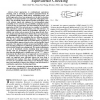92 search results - page 12 / 19 » Detecting Unknown Worms Using Randomness Check |
TVLSI
2008
13 years 8 months ago
2008
Exact approaches to combinational equivalence checking, such as automatic test pattern generation-based, binary decision diagrams (BDD)-based, satisfiability-based, and hybrid appr...
CPM
1993
Springer
14 years 20 days ago
1993
Springer
Consider a text string of length n, a pattern string of length m, and a match vector of length n which declares each location in the text to be either a mismatch (the pattern does ...
RAID
2004
Springer
14 years 1 months ago
2004
Springer
We present a formal framework for the analysis of intrusion detection systems (IDS) that employ declarative rules for attack recognition, e.g. specification-based intrusion detect...
SP
2010
IEEE
14 years 13 days ago
2010
IEEE
—Fuzz testing has proven successful in finding security vulnerabilities in large programs. However, traditional fuzz testing tools have a well-known common drawback: they are in...
DSN
2005
IEEE
14 years 2 months ago
2005
IEEE
A Cyclic Redundancy Code (CRC), when used properly, can be an effective and relatively inexpensive method to detect data corruption across communication channels. However, some sy...

